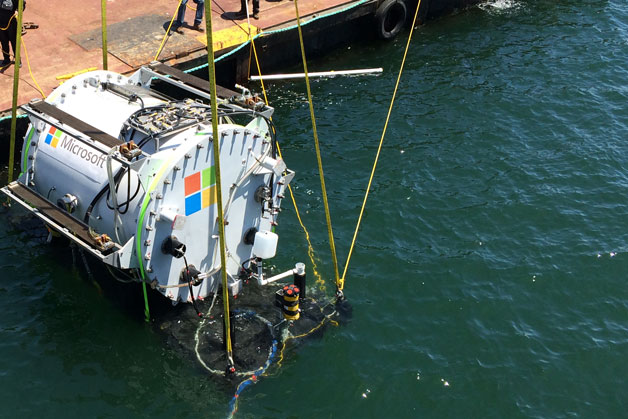The Raritan Blog
Home » Raritan Blog » The Latest Innovative Data Center Trends
The Latest Innovative Data Center Trends
Alyssa Scheyd
September 27, 2017

Data center growth is on the rise, spurred by the digital age that we're now living in. A major component and driver of this expansive growth is the popularity of the ‘Internet of Things’. Data center construction is expected grow at an incredible rate of 21% per year between now and 2018. They're such an essential part of our daily lives that 23 states now offer tax incentives to help attract new projects, while 16 others states offer tax incentives that total a combined $1.5 billion.
As the need for newer and more efficient data centers continues to increase, it demands the question - "... where exactly are we supposed to put them all?" Data centers are hardly small operations. In China, the Range International Information Hub data center covers an astounding 6.3 million square feet, just slightly smaller than the Pentagon. While not every data center makes it to this size, it's still a potential problem that has to be addressed sooner rather than later.
Thankfully, a wide range of innovative teams have worked to come up with a number of unique solutions. In terms of the latest innovative data center trends, it should come as no surprise that a large number of them have to do with optimizing physical space. Additional priorities for these teams include making resources more readily available in a more reliable, stable manner, all of which are addressed by the following examples.
Microsoft and Project Natick
If you want a clear-cut example of how far "thinking outside the box" will get you, look no further than Microsoft and Project Natick. The team behind Project Natick saw that as cloud computing continued to grow in importance worldwide, it essentially transcended its original intention. It was about more than just having "anywhere, anytime" access to data and became an essential driver of economic growth and global resources.
With that in mind, Project Natick was born in an effort to relocate data center resources as close as possible to the users who need them most. As 50% of society resides near large bodies of water, the ocean made perfect sense. This type of unique deep-water deployment concept immediately offered ready access to cooling, renewable power sources and a heavily controlled environment - all essential ingredients for successful data center operation.
Though Project Natick (and the vessel the Leona Philpot that will play a pivotal role in its existence) continues to undergo testing, analysis, and refitting, the project is closer than ever to completion.
Nautilus' Floating Data Centers
Another example of innovation in action has to do with the concept of the "floating data center." This concept takes everything you need to support the entirety of the mechanical and electrical infrastructure and installs it directly onto a floating barge.
In 2015, the startup Nautilus and its two founders, Arnold Magcale and Daniel Kekai created a plan to do precisely that in the San Francisco Bay area. They quickly started construction on a floating data center at a dock on a US Navy shipyard located just 20 miles northeast of San Francisco.
Nautilus is not the only example, however, Google also patented a tide-powered floating data center idea. Much like Project Natick, these floating data centers will get mission-critical resources as close to users as possible, all while allowing operators access to a heavily controlled environment in a way that better prepares them to meet the demands of the next ten years and beyond.
As data centers rapidly grow in numbers we can only expect more of the “out of the box” thinking in design and operations. The future holds the truth when it comes to what will be the new face of data centers. So stay tuned to this very exciting world.
Other Blog Posts
- The Rapid Growth of AI and the Use of Raritan PDUs to Meet Higher Power Demands
- Posted on October 11, 2023
- Data Center Report Fewer Outages, But Downtime Still Costly
- Posted on September 20, 2023
- Survey: Energy Usage and Staffing Shortages Challenge Data Centers
- Posted on September 20, 2023
- Raritan Secure Switch: Secure NIAP 4.0 Compliant Desktop KVM
- Posted on September 20, 2023
- The Midwest is a Hot Market for Data Centers: How the New Generation of Intelligent Rack PDUs Can Save Cloud Giants Uptime and Money
- Posted on September 7, 2023
Subscribe
Upcoming Events
- Advancing Data Center Construction West 2024
- May 6 – 8 • Salt Lake City, UT
- Net Zero Data Center
- May 16 – 17 • Dallas, TX
- 7x24 Exchange Spring
- June 9th • JW Marriott Orlando Grande Lakes
Latest Raritan News
- Legrand Certifications and Process Controls Provide Confidence in Information Security for Network-Connected Devices in Data-Related Applications
- Posted on April 1, 2024
- Legrand Releases Version 4.0 of Raritan’s Industry-Leading Secure KVM Switches, Raising Bar for Secure Desktop Access
- Posted on July 31, 2023
- Legrand Revitalizes Data Center Sector with Two Revolutionary Intelligent Rack PDUs
- Posted on May 1, 2023
- Raritan Reveals The MasterConsole® Digital Dual KVM Switch
- Posted on February 18, 2021
- Legrand Data, Power and Control Division Announced as Finalist in Six Categories at DCS Awards 2020
- Posted on November 9, 2020